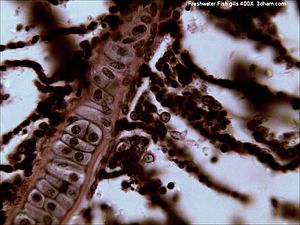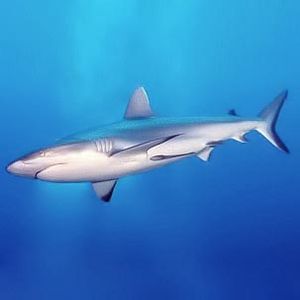Gill facts for kids
Gills are special body parts that help animals breathe underwater. Fish, amphibians, and some other animals use them. Gills have feathery parts that take oxygen from the water and release carbon dioxide.
Fish and frog gills are usually hidden on the sides of their heads. Sharks have several gill slits on their necks. Baby salamanders have gills that stick out like leaves from their heads.
Some insects that live in water have something called a plastron. It's like a special patch of tiny hairs that traps air. This air bubble acts like a gill, letting the insect breathe underwater. It helps them get oxygen and get rid of carbon dioxide while they are submerged.
Contents
How Vertebrate Gills Work
The gills of animals with backbones (called vertebrates) are usually found in the throat area. They have many comb-like parts called gill lamellae. These parts are very thin and have a large surface area, which helps them take in lots of oxygen from the water.
When a fish breathes, it opens its mouth and takes in water. Then, it closes its mouth and pushes the water out through the gill openings. As the water passes over the gills, the oxygen in the water moves into the fish's blood. At the same time, carbon dioxide from the fish's blood moves into the water and leaves the body.
Gills of Sharks and Rays
Sharks and rays are types of fish with cartilage instead of bones. They usually have five pairs of gill slits that open directly to the outside of their body. Some older types of sharks can have six or seven pairs. Between each gill slit is a support made of cartilage.
These fish also have small openings called spiracles in front of their first gill slit. These spiracles help them breathe, especially when they are resting on the bottom.
Most sharks need to keep swimming forward to force water into their mouths and over their gills. This is called "ram ventilation." But slower sharks, like skates and rays, can suck water through their spiracles to breathe without moving much.
Gills of Bony Fish
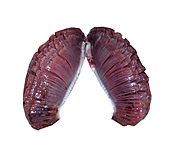
Most bony fish have their gills inside a special chamber covered by a bony flap called an operculum. The operculum helps them control the water pressure in their throat, so they don't have to swim constantly to breathe. They can pump water over their gills even when they are still. Most bony fish have five pairs of gills.
Bony fish gills usually don't have the same kind of support structure as shark gills. Instead, the gill parts stick out directly from the gill arch. Some bony fish also have small parts called gill rakers that help filter food from the water.
Fish that live in the ocean also use their gills to get rid of extra salt. Because ocean water is saltier than their bodies, they tend to lose water through their gills. To fix this, they drink a lot of seawater and then use their gills to remove the extra salt. Freshwater fish, on the other hand, gain water through their gills and need to get rid of the extra water.
Gills in Other Vertebrates
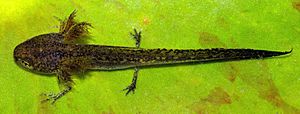
Lampreys and hagfish are ancient fish that don't have gill slits like other fish. Instead, their gills are inside round pouches with a circular opening to the outside. Lampreys have seven pairs of these pouches, while hagfishes can have six to fourteen.
Baby amphibians, like tadpoles, often have three to five gill slits. They usually have feathery external gills that stick out from the sides of their heads. These external gills usually disappear when the tadpole grows into an adult frog or salamander. However, some adult amphibians keep their external gills. Larvae of Lungfish and a primitive fish called Polypterus also have external gills.
Gills in Invertebrates
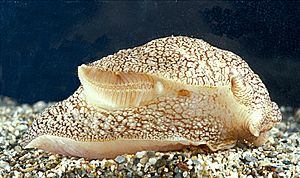
Some animals without backbones, called invertebrates, also have gills. For example, starfish and sea urchins (which are echinoderms) use simple gills called papulae. These are thin bumps on their body surface that help them breathe.
Crustaceans (like crabs and shrimp), molluscs (like snails and clams), and some insects have gills that look like tufts or flat plates on their bodies.
Some aquatic insects have tracheal gills. These gills contain air tubes that take oxygen from the water. For example, the larvae of dragonflies have special gills inside their rear end (rectum). They pump water in and out of their rectum to get oxygen for their air tubes.
Images for kids
-
The red gills of this common carp are visible because of a gill flap birth defect.
See also
 In Spanish: Branquia para niños
In Spanish: Branquia para niños


